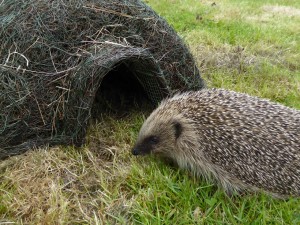
Hedgehogs are one of our most iconic British mammals and the worrying decline in numbers could mean that these snuffling spiny hogs might become a rare sight in the future. The plight of our hedgehogs and how people can help is an excellent study to introduce to children the concept of wildlife conservation and hands-on investigations about hedgehogs and their habitats. Read on for ideas to help plan your hedgehoggy investigation:
- Bug Hunt Survey: Does your school ground or wild space have enough natural food to attract hedgehogs? Hedgehogs will travel up to 2 miles a night looking for food. They love eating crunchy beetles, which apparently help keep their teeth healthy and strong, and a variety of soil invertebrates such as slugs, snails, earthworms and caterpillars. Search for and record the number of different invertebrate species and where found. Your findings might highlight the need for more log piles and compost heaps to attract more prey species for hungry hedgehogs.
- Food Chain Connections: Use the information gathered in your invertebrate survey to help illustrate how wildlife is interconnected and how small changes can affect species such as hedgehogs. Using pictures drawn by the group of their favourite invertebrate or photographs challenge the group make a food chain link to a hedgehog. Then introduce some scenarios – garden pesticides and slug pellets can poison hedgehogs, or force them to move to different areas. Hedgehogs are a good example of an omnivore species.
- Hogitat House Investigation: Make or buy a hedgehog house to put in your grounds to provide safe day nests or a place for a hedgehog to hibernate in the winter. To decide on the best location challenge your group to survey the grounds using a ‘Hedgehog Fact Sheet’ with information about where they like to nest. For example, under hedgerows, quiet sheltered places and wild corners of gardens with long grass. Can everyone agree on the best place?
Check out The British Hedgehog Preservation Society http://www.britishhedgehogs.org.uk/ for information and facts about how to create gardens for hedgehogs.
- Hedgehog Detectives: Do you have a visiting or resident hedgehog? As hedgehogs are nocturnal mammals they lead very secretive lives. Use a motion triggered trail camera to capture images and even footage of visiting wildlife. Purchase a camera that can be shared with another school /group or contact your local Mammal Society Group who can often loan cameras out. If you can’t get hold of a camera, a simple alternative is a footprint tracking tunnel.
Check out the People’s Trust for Endangered Species to learn how to become a Hedgehog Champion, record hedgehog’s sightings onto the BIG hedgehog map http://bighedgehogmap.org/ and how to set up a footprint tracking tunnel http://www.hedgehogstreet.org/pages/footprint-tunnels.html
- Hedgehog Awareness: Be proactive and help highlight the problems hedgehogs face and how everyone can help. Organise an event to encourage people to pledge one positive thing for hedgehogs, design and post leaflets for local people about how they can help hedgehogs or invite a speaker from a wildlife rescue centre to visit a community assembly – for centres in your area check out http://thehedgehog.co.uk/
